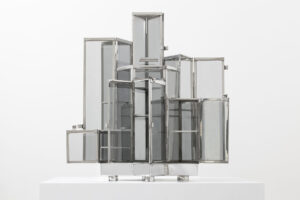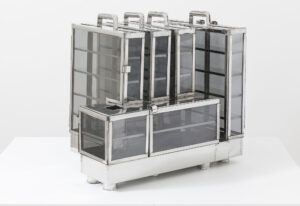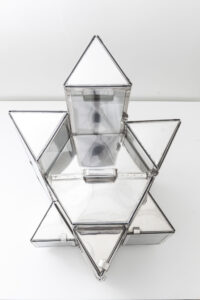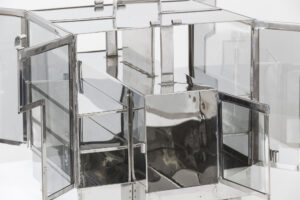Air Abraham, 2011–13
Air Abraham is the first and the centerpiece in a series of carpet works, each representing a planet in the solar system. Inspired by the legendary King Solomon’s flying carpet, it marks the beginning of the Abrahamic Cycle (2011–ongoing), which consists of four mainly sculptural installations, related both thematically and contextually. In this cycle, Vert investigates the influences of cultural heritage on sociopolitical questions and the contemporary construction of identity by examining the legendary flying carpet as an orientalist cliché. Vert returns to the roots of his multicultural heritage to disassemble questions of the present in light of his own identity with the help of mythology and history in their archaic, basic forms. He combines them with the results of his studies in disciplines like mathematics, astronomy, and numerology and brings them in different media back again as joint units that reflect our time and the conflicting influences on contemporary identity constructions in a wider context. This creates a new past and present, it generates a future symbol providing access to the values and ideas of the past for civilization’s progress in the here and now. dimension of reality in which questions between East and West, past, present, and future as well as myth, religion, and science do not collide, but rather form a bridge between one another. Taking the flying carpet of the legendary King Solomon as the central element of his artistic endeavor, Vert approaches a subject that from a Western perspective is deeply connected with the Middle East. King Solomon as prophet and king of Israel is mentioned in all three Abrahamic religions. As a sovereign ruler of men, animals, and demons, he is known not only for his wisdom, but also as a figure at the intersection between good and evil. According to the sacred texts, Solomon was given a flying carpet as a present from God who in turn had it manufactured by the devils from hell—an unlikely “collaboration” that reaches beyond the classic division of good and evil that appeared highly intriguing to the artist. In the design of the pattern, Vert combines geometric elements from ancient mythology and religious content with blueprints of early aircraft. Together, these structures form a system of lines and grids that forges a new link between cultural and historical references. It is based on the idea that historical and social phenomena as well as “softer” elements such as dreams, hopes, feelings, and larger contexts and systems can be visualized and communicated via geometric structures.
It resembles the geometric style characteristic of the Ottoman Empire as well as the Islamic concept of geometry as providing direct access to the divine, and at the same time incorporates a dense, complex and multilayered framework of references. At the center is a hexagram, a shape known to Islamic and Western occultism as well as to Jews as the Star of David. The hexagram eventually became a talisman for Jews, Christians, and Muslims in the early middle ages as protection against all evil and was incorporated as an ornament into numerous sacred buildings and religious writings, demonstrating the relationship between God and humans through the two inner triangles facing one another. Based on the same geometric structures is the so-called “Flower of Life,” a symbol of protection in modern mysticism, and the designs by Adam Graham Bell for tetrahedral kites that are the foundation of modern aviation and the understanding that geometry forms the basis of all life in the universe. In the graphic and symbolic design of Air Abraham, the hexagram is modified to a variety of shapes connected by lines resembling the Nazca Lines from the desert in southern Peru (500 BC to AD 500). Visible even from space, the Nazca Lines are related to astronomy and cosmology. They represent the search for “something higher” as well as for the future and science fiction as a component of contemporary western cultural heritage. The intersections of the lines are highlighted with colors, serving as a metaphor for the overlap of different cultures while resembling the cockpit of a futuristic starship. Following the idea that cultural identity is particularly inherent in everyday objects, Air Abraham was handwoven in a traditional carpet workshop in south central Turkey and represents a characteristic of local heritage and the extraordinary significance of the art of carpet-making in the Middle East. Manufactured by Anatolian artisan families using a traditional technique used since the Seljuk Empire (eleventh to fourteenth century), the production process was aimed at being as authentic as possible: the carpet was handmade of sheep’s wool and cotton dyed with only natural colors, using the technique of the so-called Turkish double knot (Ghiordes knot). The work opens a formative dialogue about past and present, Western imagination and orientalization, as well as high culture and everyday life, as the flying carpet also finds its way into pop culture via TV ads and programs since the nineteen-fifties where it was used as a promotional tool for new technologies such as vacuum cleaners and aspirators. Furthermore, in its transcultural dynamic reception, interpretation, and modification the legend of the flying carpet demonstrates an interaction between cultures, serving as a symbol of fantasy and discovery of other worlds. And as an embodiment of the ancient dream of flying, the carpet also symbolizes the future—even today in times of aviation, aerospace, and space travel. Air Abraham expresses the urgency to confront leading questions of the present with aspects of cultural heritage, eventually hoping to unite them.
By entangling components of Middle Eastern and Western culture as well as past and present, it generates a future symbol providing access to the values and ideas of the past for civilization’s progress in the here and now.
Abraham 1, 2014
A metamorphosis of the work Air Abraham that takes the research to a new dimension in an interplay between past, present, and future, Abraham 1 deals with the interface between mythology, science, and the complexity of life. Based on the ancient myth of the flying carpet, particularly on the story of how the carpet is brought to fly, Vert constructs a “flying object.” In accordance with the legend that the carpet can actually—following the artist’s interpretation—function as a door to a new dimension, Abraham 1 overcomes not only spatial but also temporal distances while it creates its own new universe through the interdisciplinary combination of its components. Already in his selection of materials and craftsmanship, Vert associates past, present, and future by customizing the individual parts of the sculpture in wood and brass with traditional techniques in the workshops of Istanbul. In reference to the fantastic novels by Jules Verne with their meticulous descriptions of the beauty of technological progress and machines, the design is limited to strict geometric shapes and technically oriented details, resulting in a structure that appears both ancient and futuristic as it recalls forms of aircraft at the dawn of aviation, as well as space travel, astronautics, and their prevalence in nineteen-eighties pop culture. Both stand for and allegorize the human longing for the exploration of the unknown, for the beginning of a journey in search for new answers. Vert takes up elements of mathematics, astronomy, and physics as well as aspects of numerology, astrology, and esotericism and combines them into a holistic, comprehensive attempt at explanation. At the center of the sculpture is a volume in the form of a hexagon. It separates the inside from the outside, the micro-level from the macro-level, the sky from the earth, the known from the unknown. The hexagonal volume is cannulated by nearly 900 screws fixing plates in the form of stellar constellations on the outside, while on the inside each bolt represents a star of our solar system as visible from Earth. From a certain perspective, the bars inside with adjunct balls can be connected to a geometric structure similar to the amplituhedron that was introduced by quantum physicists only recently in 2013. The viewer can thus experience how, under certain circumstances, suddenly and unexpectedly, entirely new dimensions can open up. The delicate plates that are attached like wings or sails to the outer skin of the hexagonal volume letting the massive structures seem to levitate against all the laws of physics also play with the perception of the viewer. While the sculpture appears like an inverted universe where the stars are not on the outside but on the inside, the wing-like plates represent the Earth when put together like pieces of a puzzle as their pattern composes a large map. The sculpture thus unites elements that in their specific combination suspend pre-existing ideas and open dimensions of a new reality. Although or perhaps because Abraham 1 can be understood as a plea for fantasy, it forms in its lavish opulence and in its embodiment of said underlying ideas a completely outdated counterpoint to contemporary social and artistic trends. Not only does it consistently play with the epochs, but the romanticism associated with the material and subject matter itself becomes a piece of political provocation.
The Chronicler, 2012–14
The multimedia installation The Chronicler represents the third stage in the Abrahamic Cycle, an even deeper convergence to the next dimension that Vert aims to shed light on throughout his research on the mythology of the flying carpet. In this work, that is a direct continuation of Abraham 1, Vert puts the amplituhedron as the focus of his artistic research to pursue the question of what is inside this golden machine—in terms of materiality and notional content— what is at its center. The amplituhedron is a geometric structure introduced in quantum field theory in 2013 to enable simplified calculation of particle interactions. It provides a much more intuitive geometric model for calculations whose underlying principles were until then highly abstract. From an artistic point of view, processes and interaction in areas besides quantum physics can be catalyzed with the amplituhedron. Therefore, the amplituhedron resembles a link, an “aeonian key” to the immeasurable and indefinite timely expansion of the universe, which allows for travel to other dimensions and which supports Vert’s ambition to connect cultures, disciplines, and ages to find information about the composition of human identity. In that way, Vert draws parallels between this newly discovered geometric structure and its unrealized possibilities. The legend of the flying carpet might be activated only by use of a special “key” in the form of a seal or an amulet. The installation consists of a 3D animated film and seven mirror objects with a sanded grid, each representing a fragment of the amplituhedron that if combined would reveal its whole structure. Mounted on the walls, ceiling, and floor of the exhibition space, the amplituhedron is presented in a fragmented, two-dimensional form as a floating carrier of abstract patterns and formulas with religious elements. Most importantly, the single elements are arranged in a way that puts the visitor at the center of the work, both his physical presence and his many reflections in the mirrors. The 3D animation shows an abstracted form of the formation process of the amplituhedron. The seven pieces are mystically floating through a space-like environment that recalls science fiction movies or computer games from the nineteen-eighties, each in a different very earthly material such as marble, copper, or wood. Eventually, they merge to form an abstract object that clearly shows the insignia of the three big monotheistic religions— Judaism, Christianity, and Islam—as well as mathematic symbols on its surface. Accompanied by a spherical sound collage, the voice of the artist recites the spelling alphabet in seven different languages. They correspond to the number of languages Vert grew up with. The number 7 plays a key role in this work: seven languages, seven fragments, seven materials. According to numerology, which is another fundamental source for Viron Erol Vert, the number 7 is the seeker, the thinker, the searcher of truth. By rooting this work again in his own personal multi-ethnic background, Vert poses the question of how identity is constructed and shaped by all the different cultural influences and patterns, the existential question of who we are. The work was developed in close curatorial collaboration with Misal Adnan Yıldız for Vert’s eponymous first institutional solo exhibition at Künstlerhaus Stuttgart in 2014. Its title refers to the recording of events in chronological order without hierarchization of said event’s significance or historical weight, as in the Ottoman court chronicles Vak’a-Nüvis, which are official accounts of the imperial history recorded by the sultan’s court chronicler.
Abrahamic Displays 1, 2013
Installation view of the solo 2012 This series of hand-made sculptures is dedicated to the Abrahamic religions Judaism, Christianity, and Islam, the big monotheistic religions that all find their origin in one spiritual source. As much as they all come together in Vert’s own family background, they are also emblematically linked and deeply interwoven with the history of Istanbul. For each religion, Vert created one empty vitrine resembling the materiality of the old, yet vanishing Istanbul street culture with its seyyar satıcılar [flying street vendors]. Following Vert’s understanding, the materials of everyday culture function as a contact organ, like the skin of the city. The work takes inspiration from the small portable showcases made of glass and chromed tin that are used for selling any kind of food or sweets. As it is central to his artistic methodology, Vert had these vitrines custom-made in a traditional workshop in Istanbul’s old artisans quarter of Tahtakale on the Golden Horn, an area with little shops and workshops in the streets, bazaars and people hawking goods on handcarts, makeshift stalls, or on blankets laid out in the streets between the big stone fortresses from the Byzantine and Ottoman era, called han in Turkish. In that sense, the Abrahamic Displays also pay tribute to the increasingly disappearing micro-businesses and handicrafts from Ottoman times. Seen from above, the vitrines each reveal the shape of a symbol of the three religions, the Star of David, the cross, and the name of Allah in the early Arabic calligraphic form of Kufic writing. Vert transforms the originally small objects from street culture into complex structures reminiscent of the skylines in neoliberal banking districts and the iconic examples of steel-glass architecture of modernism, also referred to as Cathedrals of Modernity. The vitrines are empty; with the doors partly open, they allow reflections on their spiritual dimension and the opportunities they offer to be filled with something new. At the same time, they pose the question of the relevance that religions have today as closed systems that are based on delimitation. Placed on black and white pedestals representing the duality of life as found in ancient Chinese philosophy, they allow associations to little temples on small hills reminiscent of the early ages of worship and religion.
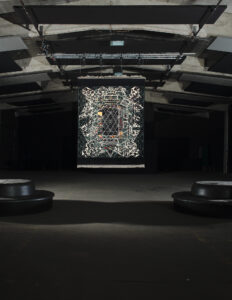
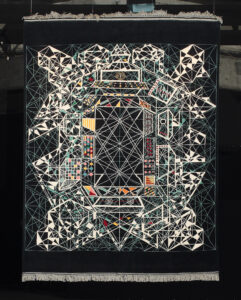
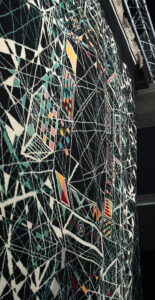
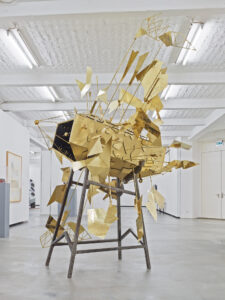
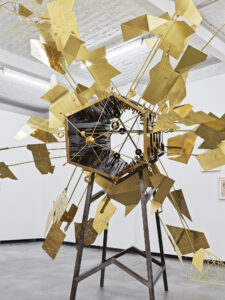
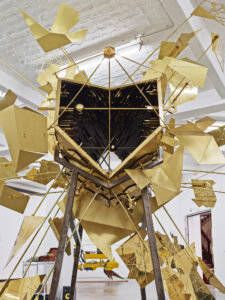
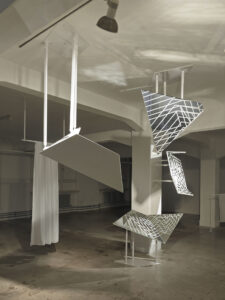
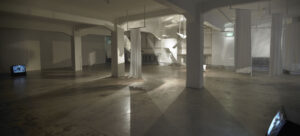
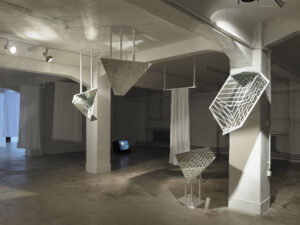
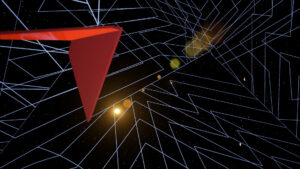
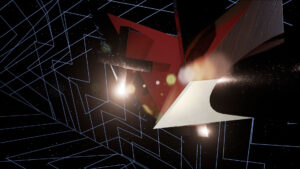
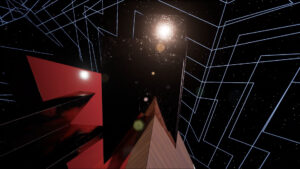
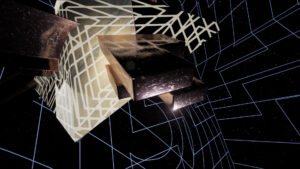
![7 Curtains, Installation view of the solo exhibition 7 Curtains, İplik Fabrikası [Yarn Factory], Hasköy, Galerist Istanbul, 2012; photo: the artist](https://www.brokenarchive.org/wp-content/uploads/2021/03/VEV_1_7Curtains_Installation_view_2013_WEB-300x200.jpg)
